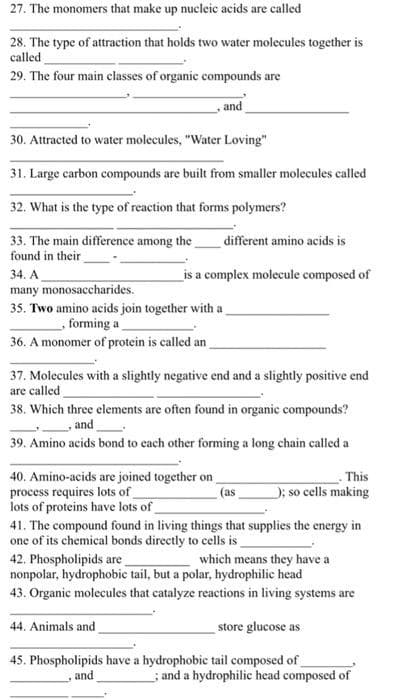Introductory Chemistry: A Foundation
9th Edition
ISBN:9781337399425
Author:Steven S. Zumdahl, Donald J. DeCoste
Publisher:Steven S. Zumdahl, Donald J. DeCoste
Chapter20: Organic Chemistry
Section: Chapter Questions
Problem 126AP
Related questions
Question
One words fillups answer as many as u can at least 27-37
else will give u downvote

Transcribed Image Text:27. The monomers that make up nucleic acids are called
28. The type of attraction that holds two water molecules together is
called
29. The four main classes of organic compounds are
and
30. Attracted to water molecules, "Water Loving"
31. Large carbon compounds are built from smaller molecules called
32. What is the type of reaction that forms polymers?
33. The main difference among the
different amino acids is
found in their
34. A
_is a complex molecule composed of
many monosaccharides.
35. Two amino acids join together with a
forming a
36. A monomer of protein is called an
37. Molecules with a slightly negative end and a slightly positive end
are called
38. Which three elements are often found in organic compounds?
and
39. Amino acids bond to each other forming a long chain called a
40. Amino-acids are joined together on
process requires lots of
lots of proteins have lots of
41. The compound found in living things that supplies the energy in
one of its chemical bonds directly to cells is
This
(as
); so cells making
42. Phospholipids are
nonpolar, hydrophobic tail, but a polar, hydrophilic head
43. Organic molecules that catalyze reactions in living systems are
which means they have a
44. Animals and
store glucose as
45. Phospholipids have a hydrophobic tail composed of
and
; and a hydrophilic head composed of
Expert Solution
This question has been solved!
Explore an expertly crafted, step-by-step solution for a thorough understanding of key concepts.
This is a popular solution!
Trending now
This is a popular solution!
Step by step
Solved in 2 steps with 2 images

Knowledge Booster
Learn more about
Need a deep-dive on the concept behind this application? Look no further. Learn more about this topic, chemistry and related others by exploring similar questions and additional content below.Recommended textbooks for you

Introductory Chemistry: A Foundation
Chemistry
ISBN:
9781337399425
Author:
Steven S. Zumdahl, Donald J. DeCoste
Publisher:
Cengage Learning

Chemistry & Chemical Reactivity
Chemistry
ISBN:
9781337399074
Author:
John C. Kotz, Paul M. Treichel, John Townsend, David Treichel
Publisher:
Cengage Learning

Chemistry & Chemical Reactivity
Chemistry
ISBN:
9781133949640
Author:
John C. Kotz, Paul M. Treichel, John Townsend, David Treichel
Publisher:
Cengage Learning

Introductory Chemistry: A Foundation
Chemistry
ISBN:
9781337399425
Author:
Steven S. Zumdahl, Donald J. DeCoste
Publisher:
Cengage Learning

Chemistry & Chemical Reactivity
Chemistry
ISBN:
9781337399074
Author:
John C. Kotz, Paul M. Treichel, John Townsend, David Treichel
Publisher:
Cengage Learning

Chemistry & Chemical Reactivity
Chemistry
ISBN:
9781133949640
Author:
John C. Kotz, Paul M. Treichel, John Townsend, David Treichel
Publisher:
Cengage Learning

Principles of Modern Chemistry
Chemistry
ISBN:
9781305079113
Author:
David W. Oxtoby, H. Pat Gillis, Laurie J. Butler
Publisher:
Cengage Learning

Chemistry: An Atoms First Approach
Chemistry
ISBN:
9781305079243
Author:
Steven S. Zumdahl, Susan A. Zumdahl
Publisher:
Cengage Learning
